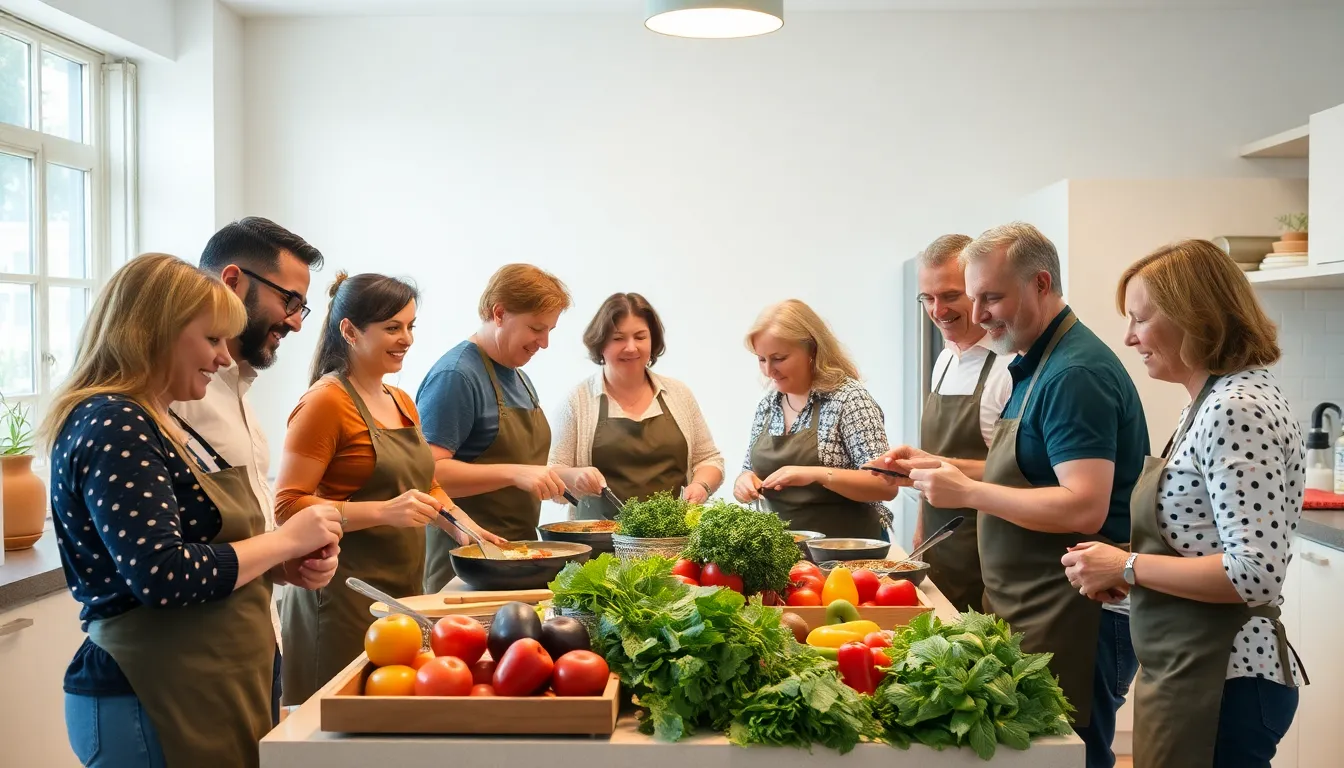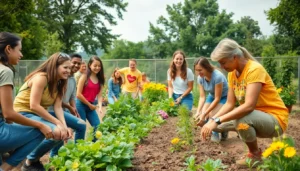Table of Contents
ToggleImagine stepping into a kitchen where the only thing missing is your chef’s hat and a sprinkle of culinary magic. Hands-on cooking experiences offer the perfect blend of fun and flavor, transforming anyone into a kitchen whiz—at least for a night. Whether you’re a novice who thinks a whisk is a bird or a seasoned pro looking to spice things up, these interactive sessions promise laughter, learning, and a chance to unleash your inner Gordon Ramsay without the shouting.
Overview of Hands-On Cooking Experiences
Hands-on cooking experiences offer a dynamic way for individuals to engage with culinary arts. Participants immerse themselves in the cooking process, developing practical skills along the way. Many programs cater to various skill levels, ensuring inclusivity for both novices and experienced cooks.
Interactive cooking classes create a relaxed environment where laughter often accompanies learning. Recipes chosen for these sessions generally highlight accessible ingredients, allowing for creativity without intimidation. Instruction typically emphasizes fundamental techniques, equipping participants with essential culinary tools.
Class sizes vary, enabling personalized attention from chefs. Smaller groups foster interaction, making it easier for participants to ask questions and receive feedback. Larger classes benefit from the energy of community cooking, motivating individuals to bond over shared experiences.
Equipment used in these classes often includes high-quality tools that enhance the cooking experience. From sharp knives to state-of-the-art appliances, access to professional-grade equipment elevates the outcome of the dishes prepared. Participants leave not only with new recipes but also with the confidence to recreate meals at home.
Culinary workshops frequently feature themes, such as international cuisines or specific cooking techniques. Seasonal ingredients may inspire classes, promoting sustainability while encouraging participants to explore diverse food cultures. Those who attend hands-on cooking experiences gain more than just culinary knowledge; they build lasting memories through shared meals and newfound friendships.
Benefits of Hands-On Cooking Experiences

Hands-on cooking experiences offer numerous advantages that enhance culinary skills and creativity. Participants engage directly with the cooking process, leading to practical skill development.
Skill Development
Skill development occurs in a supportive environment where individuals learn at their own pace. Fundamental techniques are emphasized throughout sessions, allowing everyone to build a solid foundation. Novices gain confidence as they tackle new recipes, while experienced cooks refine their skills further. Instruction often includes personalized feedback, which proves invaluable for improving techniques. Engaging in hands-on activities develops muscle memory, making cooking feel more instinctual. Regular practice in a group setting fosters camaraderie and motivation, encouraging participants to experiment with new ideas.
Culinary Creativity
Culinary creativity flourishes during these interactive sessions. Participants explore vibrant ingredients and develop an understanding of flavor combinations. Exposure to various cooking styles promotes innovative thinking when creating dishes. Many workshops incorporate themes like international cuisines, driving the exploration of diverse culinary techniques. Opportunities arise to customize recipes, allowing individual expression in the kitchen. Creativity also stems from working collaboratively, as sharing insights among peers enhances the overall experience. Ultimately, hands-on cooking experiences empower individuals to think outside the box when preparing meals at home.
Types of Hands-On Cooking Experiences
Hands-on cooking experiences come in various forms, each offering unique benefits and opportunities for engagement. Participants can choose from cooking classes, workshops, and events that cater to different interests and skill levels.
Cooking Classes
Cooking classes provide structured learning environments facilitated by professional chefs. Participants practice essential techniques while preparing diverse dishes. These classes often focus on specific cuisines, allowing individuals to explore different flavors and cooking methods. Personalized feedback helps novice cooks gain confidence, while seasoned chefs refine their skills. Classes typically accommodate small groups, enhancing interaction and support. This dynamic setting encourages collaboration among attendees as they share their culinary journeys. Accessible recipes and ingredients promote creativity, simplifying the process of mastering new skills.
Workshops and Events
Workshops and events offer immersive experiences centered around specific culinary themes or techniques. Participants may explore seasonal ingredients or international cuisines, enhancing their culinary repertoire. These gatherings often foster community through shared cooking tasks and tastings. Participants exchange tips and stories, enriching the experience through social interaction. Smaller group sizes ensure that instructors provide individual attention, maintaining a personalized learning atmosphere. Unique topics, such as baking or knife skills, engage participants while expanding their culinary knowledge. The combination of structured guidance and creative freedom makes these workshops enjoyable and memorable experiences.
Popular Themes in Hands-On Cooking Experiences
Hands-on cooking experiences often embrace various themes that spark interest and engagement. Each theme provides unique insights and skills tailored to participants’ culinary journeys.
International Cuisine
International cuisine classes immerse participants in the flavors and techniques from around the world. Participants explore dishes from Italy, Mexico, Japan, and more. Each session focuses on cultural significance, preparing recipes that highlight regional ingredients. Engaging with authentic techniques, attendees gain knowledge about spices, herbs, and cooking methods specific to different cultures. These experiences foster appreciation for diverse culinary traditions while allowing individuals to create globally inspired dishes in their kitchens.
Healthy Cooking
Healthy cooking classes emphasize nutritious ingredients and balanced meals. Participants learn to prepare dishes that prioritize freshness and flavor without compromising health. Techniques often include meal prepping, making nutrient-dense alternatives, and focusing on seasonal produce. Each class highlights how to substitute less healthy ingredients while maintaining great taste. By exploring various cooking methods like steaming and grilling, individuals discover how easy it is to create wholesome meals. These experiences empower attendees to build confidence in their ability to cook healthy, satisfying dishes at home.
Tips for Choosing the Right Experience
Consider personal interests when selecting a hands-on cooking experience. Evaluating preferred cuisines can guide choices, whether participants favor Italian, Asian, or Mediterranean flavors. Research local offerings to find experiences that suit specific tastes and skill levels.
Look for classes led by experienced chefs. Engaging instructors enhance learning through their expertise and culinary backgrounds. Small class sizes often provide personalized attention, allowing participants to ask questions and receive feedback directly.
Review session formats. Some classes focus on technique, while others emphasize creativity or cultural exploration. Deciding between structured learning and freer experimentation can help participants align expectations with what they’ll gain from the experience.
Investigate the ingredients used in classes. Fresh, seasonal ingredients not only promote sustainability but also contribute to a more enjoyable cooking process. Understanding whether experiences feature accessible ingredients helps in choosing the right opportunity for all skill levels.
Check participant reviews before booking. Feedback from past attendees offers insight into what to expect and can highlight the strengths of specific classes or workshops. Identifying programs with high satisfaction rates often leads to more fulfilling experiences.
Compare pricing and what’s included. Some classes offer high-quality equipment, ingredients, or additional materials that enhance learning. Evaluating the total value of the experience can help in making informed decisions.
Evaluate the location and duration of the classes. Convenience plays a significant role, as does the time commitment required. Choosing nearby options that fit into a busy schedule allows for maximum participation without unnecessary stress.
Hands-on cooking experiences offer an enriching journey into the culinary world that transcends traditional learning. Participants not only develop essential cooking skills but also cultivate creativity and confidence in the kitchen. The engaging nature of these sessions fosters a sense of community and connection among attendees, making cooking a shared adventure rather than a solitary task.
With diverse themes and formats available, there’s something for everyone. Whether it’s mastering international dishes or exploring healthy cooking, these experiences empower individuals to embrace their culinary passions. By choosing the right class, participants can unlock new flavors and techniques that enhance their cooking repertoire. Ultimately, hands-on cooking experiences leave lasting impressions and inspire a lifelong love for cooking.






